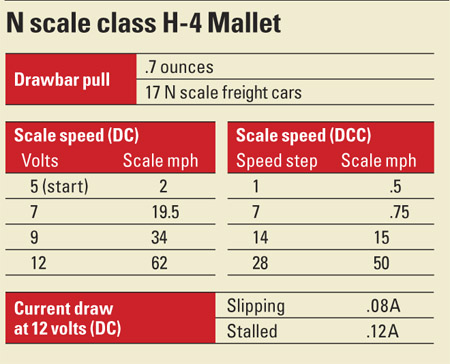Manufacturer: Bachmann Trains
Road numbers: (all C&O) 1340, 1397, 1436, 1439. Painted, unlettered version also available.
Comments: The H-4 Mallet is also available as an N scale ready-to-run model. As with the HO version, Bachmann modified its United States Railway Administration 2-6-6-2 to resemble an H-4. (For a review of the Bachmann N scale USRA Mallet, see the November 2005 Model Railroader.) The model includes a dual-mode DCC decoder that operates on direct current and Digital Command Control layouts but doesn’t feature a sound system.
The locomotive boiler, cab, and tender are plastic and have many separately applied detail parts. These include the bell, whistle, handrails, air pumps, and much of the locomotive piping.
Like the HO model, the N scale H-4 has a detailed cab interior with painted walls and a molded boiler backhead. The N scale model doesn’t have painted crew figures or a hinged cab apron.
The model’s motor and flywheel are inside the locomotive boiler. Two worms transfer power from the motor to the second axle on the front and rear engine. The siderods turn the other drivers.
The Mallet has a die-cast metal locomotive frame. The front and rear engines are hinged. The model has a 9″ minimum radius but looks better on a 15″ or greater radius curves.
The locomotive and tender weigh 41/2 ounces and are permanently tethered. Wires run from the front of the tender to the rear of the cab. The DCC decoder is accessed by removing the tender’s coal load. The drawbar between the locomotive and tender is attached with two screws. Copper contacts run along each side of the drawbar.
On a DCC test track the model didn’t start moving until speed step 10 with the decoder set to 28 speed steps. After setting the model’s starting voltage (configuration variable or CV 2) to 31, the locomotive moved smoothly at .5 scale mph in speed step 1. This speed remained flat until speed step 10, when the model moved at 1.5 scale mph and then increased steadily to a top speed of 50 scale mph as I advanced the DCC throttle. The decoder does support 128 speed steps, but, especially at the low end, I found this setting to be more cumbersome for such a shallow speed curve.
I also turned the headlight on and off using function 0 and dimmed the headlight using function 1. The model has an operating backup light that automatically turns on when the locomotive is in reverse. Both the headlight and backup light are light-emitting diodes (LEDs).
Like the HO version, the Bachmann N scale Mallet doesn’t exactly match a prototype C&O class H-4. However, it provides an option for steam-era fans to add an articulated locomotive to their rosters.















